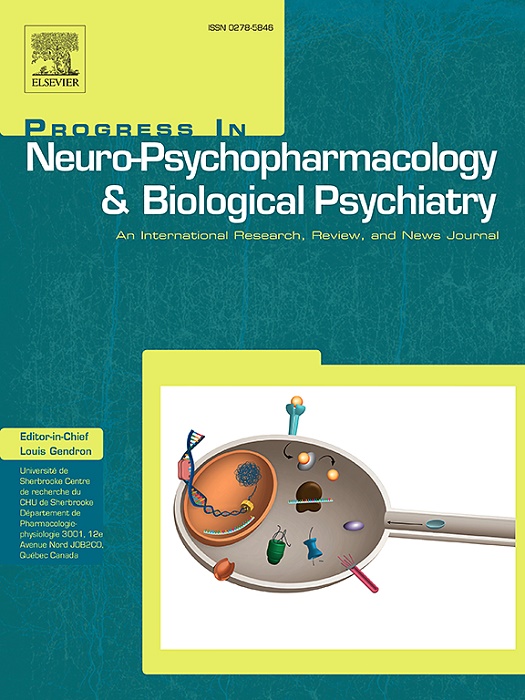Unravelling gender differences in cannabis cue-reactivity in individuals who use cannabis
IF 3.9
2区 医学
Q1 CLINICAL NEUROLOGY
Progress in Neuro-Psychopharmacology & Biological Psychiatry
Pub Date : 2025-10-02
DOI:10.1016/j.pnpbp.2025.111515
引用次数: 0
Abstract
The development of cannabis use disorder (CUD) shows notable gender differences. While men have a higher overall prevalence of CUD, women transition more rapidly from initial use to CUD and often present with more severe psychiatric symptoms when seeking treatment. Despite these clinical observations, research into the neural mechanisms underlying these gender differences remains limited. This study aimed to investigate gender-dependent differences in neural cue-reactivity and session-induced craving (change in craving from the beginning to end of the experimental session) among regular cannabis users and non-using controls, as well as gender-specific associations between neural cue-reactivity, craving, and cannabis use characteristics.
A total of 66 regular cannabis users (27 women), who used cannabis 2 to 7 days per week, and 71 controls (31 women) completed a functional MRI cannabis cue-reactivity task involving exposure to cannabis-related and neutral images. Craving was measured twice using the Marijuana Craving Questionnaire, which measures craving related to the loss of control, relief from negative affect, anticipated positive outcomes, and intention to use. To assess session-induced craving, craving at the end of the experimental session was subtracted from craving at the beginning of the experimental session.
Results revealed that women who use cannabis displayed blunted neural cue-reactivity in the right insula and putamen compared to men, a pattern opposite to that seen in controls. Among women, but not men, session-induced relief and reward craving correlated positively with cue-reactivity in the right superior frontal gyrus, cerebellum, and precentral gyrus. Additionally, cannabis use severity was linked to cue-reactivity in the precentral gyrus in women only
These findings underscore complex, gender-related interactions between neural responses, craving, and cannabis use severity, emphasizing the need for gender-tailored research to address critical gaps in understanding the development and treatment of CUD.
揭示大麻使用者中大麻线索反应的性别差异。
大麻使用障碍(CUD)的发展表现出显著的性别差异。虽然男性的CUD总体患病率较高,但女性从最初使用到CUD的过渡速度更快,并且在寻求治疗时往往表现出更严重的精神症状。尽管有这些临床观察,但对这些性别差异背后的神经机制的研究仍然有限。本研究旨在探讨常规大麻使用者和非大麻使用者在神经线索反应性和会话诱导的渴望(从实验开始到结束的渴望变化)方面的性别差异,以及神经线索反应性、渴望和大麻使用特征之间的性别特异性关联。共有66名经常使用大麻的人(27名女性),每周使用大麻2至7次 天,以及71名对照组(31名女性)完成了一项功能性MRI大麻线索反应任务,涉及暴露于大麻相关图像和中性图像。使用大麻渴望问卷对渴望进行了两次测量,该问卷测量了与失去控制、从负面影响中解脱、预期积极结果和使用意图相关的渴望。为了评估会话诱导的渴望,实验结束时的渴望从实验开始时的渴望中减去。结果显示,与男性相比,使用大麻的女性在右脑岛和壳核表现出迟钝的神经线索反应,这与对照组的模式相反。在女性中,而不是男性中,会话诱导的缓解和奖励渴望与右侧额上回、小脑和中央前回的线索反应正相关。此外,仅在女性中,大麻使用严重程度与中枢前回的线索反应有关:这些发现强调了神经反应、渴望和大麻使用严重程度之间复杂的、与性别相关的相互作用,强调了针对性别的研究的必要性,以解决在理解反刍反应的发展和治疗方面的关键差距。
本文章由计算机程序翻译,如有差异,请以英文原文为准。
求助全文
约1分钟内获得全文
求助全文
来源期刊
CiteScore
12.00
自引率
1.80%
发文量
153
审稿时长
56 days
期刊介绍:
Progress in Neuro-Psychopharmacology & Biological Psychiatry is an international and multidisciplinary journal which aims to ensure the rapid publication of authoritative reviews and research papers dealing with experimental and clinical aspects of neuro-psychopharmacology and biological psychiatry. Issues of the journal are regularly devoted wholly in or in part to a topical subject.
Progress in Neuro-Psychopharmacology & Biological Psychiatry does not publish work on the actions of biological extracts unless the pharmacological active molecular substrate and/or specific receptor binding properties of the extract compounds are elucidated.

 求助内容:
求助内容: 应助结果提醒方式:
应助结果提醒方式:


